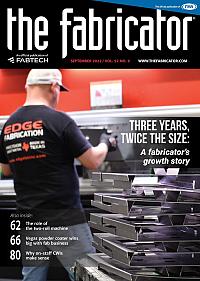Senior Editor
- FMA
- The Fabricator
- FABTECH
- Canadian Metalworking
Categories
- Additive Manufacturing
- Aluminum Welding
- Arc Welding
- Assembly and Joining
- Automation and Robotics
- Bending and Forming
- Consumables
- Cutting and Weld Prep
- Electric Vehicles
- En Español
- Finishing
- Hydroforming
- Laser Cutting
- Laser Welding
- Machining
- Manufacturing Software
- Materials Handling
- Metals/Materials
- Oxyfuel Cutting
- Plasma Cutting
- Power Tools
- Punching and Other Holemaking
- Roll Forming
- Safety
- Sawing
- Shearing
- Shop Management
- Testing and Measuring
- Tube and Pipe Fabrication
- Tube and Pipe Production
- Waterjet Cutting
Industry Directory
Webcasts
Podcasts
FAB 40
Advertise
Subscribe
Account Login
Search
The technical and systems thinking of metal fabrication
Metalworking shops with the right balance tend to thrive in manufacturing
- By Tim Heston
- September 27, 2022
- Article
- Shop Management
In a recent Fabrinomics newsletter from the Fabricators & Manufacturers Association, Chris Kuehl, economic analyst, discussed the dichotomy of the summer’s economy. He quoted a UBS survey of investors and business owners about how they’re preparing for the next recession, whenever it might come.
“Nearly all of those respondents stated that they have been avoiding layoffs,” Kuehl wrote, “as they are worried they will not be able to replace those they would dismiss.”
People might feel we’re on the brink of a recession, yet outside a few isolated sectors, hiring remains strong and layoffs aren’t widespread. One reason behind this might be about people. Employers had a bear of a time finding good people, and they don’t want to lose them now, especially during these unprecedented times. Supply, not demand, is the problem. Demand hasn’t abated, and businesses want good people in place to meet that demand when supply issues finally ebb.
Many busy fab shops, the beneficiaries of reshoring and a reshaping domestic supply chain, couldn’t imagine laying off people now. That said, when the next slowdown comes, layoffs might not be so pervasive. Part of this has to do with demographics. Boomers are retiring, leaving a large experience gap—particularly in areas of manufacturing that experienced serious declines from globalization in the 1980s and 1990s. Many shops just don’t have that many employees between aging boomers and relatively inexperienced millennials.
Metal fabrication has another complication: It’s a group of manufacturing processes, not a well-defined industry, and the specifics behind those processes change with the products being built. Fundamentally, this business requires a mix of people who think about work in different ways. I tend to group them into two buckets: systems thinkers and technical thinkers.
We tackle the jobs other shops turn away. Hearing this tells me that technical thinkers are a driving force within a shop. I recall one job shop supervisor showing me an unusual stainless steel workpiece that was bump-formed on the press brake. Certain features made conventional setups impractical; it was all about how the operator sequenced the incremental bends, combined with some unique gauging strategies. The supervisor and operator worked together, experimented with different bend sequences and gauging strategies, then high-fived when they found a solution. “These are the fun days,” the supervisor told me.
There’s a huge market for technical thinkers. There remains plenty of specialized products that are difficult to fabricate, and no design alteration would change that. On top of this, manufacturing has a shortage of engineers familiar with sheet metal. In a purely rational market, without silos or fiefdoms or burdensome bureaucracies that make change difficult, design for manufacturability (DFM) would be more pervasive. But the market isn’t always rational, and the engineer shortage is real, so a fab shop’s technical thinker is there to save the day.
Complementing these people are systems thinkers. They like engineering-out problems, and they think about workflow and the ripple effects technical challenges create. They might see that same supervisor and operator high-five each other and sigh in relief; they see it as a problem overcome and, indeed, something to avoid in the future, considering the ripple effects and bottlenecks created by people mucking around in front of the machine. The shop makes money when products ship, not when people experiment in front of a machine to make the unmanufacturable manufacturable.
The systems thinker values long-term customer relationships built on reliability and on-time delivery. The technical thinker values those same customer relationships, but for a different reason; they help customers by making the seemingly impossible possible.
I see technical thinkers and system thinkers as the yin and yang of metal fabrication, and finding the right balance is what truly shapes a metal fabrication business. When a fabricator has the right mix, technology and automation amplify operational strengths. Say a fabricator invests in an automatic-tool-change press brake to change over frequently between various complicated jobs. It’s about flexibility—the ability to break into production and change gears on a dime. It’s not a Band-Aid that covers up a lack of knowledge and skill.
An operation dominated by technical thinkers might suffer from organizational chaos. They thrive in making the impossible possible, but sustaining the chaos over the long term isn’t easy. The environment overwhelms people, so they leave in frustration.
An operation dominated by systems thinkers might avoid challenging (and profitable) work. Even worse, they could treat operators as mere pawns, there to be manipulated as part of a broader strategy. Operators become just another warm body, there to produce but not think. When the shop automates, they plant a warm body in front of the machine. That warm body pushes buttons to, say, initiate an automated tool change, but they really don’t know how and why the automation does what it does. They’re there to collect a paycheck.
When a shop has the right mix of people, everything just clicks, manufacturing technology amplifies everyone’s strengths, and talented people stay on for decades. The perfect mix can be extraordinarily difficult to attain. That’s why, in the face of inflation and economic uncertainty, the most competitive fabricators aren’t about to let people go. The elusive “perfect mix” is also why finding good people forever remains at the top of the industry’s challenges. Without the right people, everything else becomes a struggle.
About the Author

Tim Heston
2135 Point Blvd
Elgin, IL 60123
815-381-1314
Tim Heston, The Fabricator's senior editor, has covered the metal fabrication industry since 1998, starting his career at the American Welding Society's Welding Journal. Since then he has covered the full range of metal fabrication processes, from stamping, bending, and cutting to grinding and polishing. He joined The Fabricator's staff in October 2007.
subscribe now

The Fabricator is North America's leading magazine for the metal forming and fabricating industry. The magazine delivers the news, technical articles, and case histories that enable fabricators to do their jobs more efficiently. The Fabricator has served the industry since 1970.
start your free subscription- Stay connected from anywhere

Easily access valuable industry resources now with full access to the digital edition of The Fabricator.

Easily access valuable industry resources now with full access to the digital edition of The Welder.

Easily access valuable industry resources now with full access to the digital edition of The Tube and Pipe Journal.
- Podcasting
- Podcast:
- The Fabricator Podcast
- Published:
- 04/16/2024
- Running Time:
- 63:29
In this episode of The Fabricator Podcast, Caleb Chamberlain, co-founder and CEO of OSH Cut, discusses his company’s...
- Industry Events
16th Annual Safety Conference
- April 30 - May 1, 2024
- Elgin,
Pipe and Tube Conference
- May 21 - 22, 2024
- Omaha, NE
World-Class Roll Forming Workshop
- June 5 - 6, 2024
- Louisville, KY
Advanced Laser Application Workshop
- June 25 - 27, 2024
- Novi, MI
































